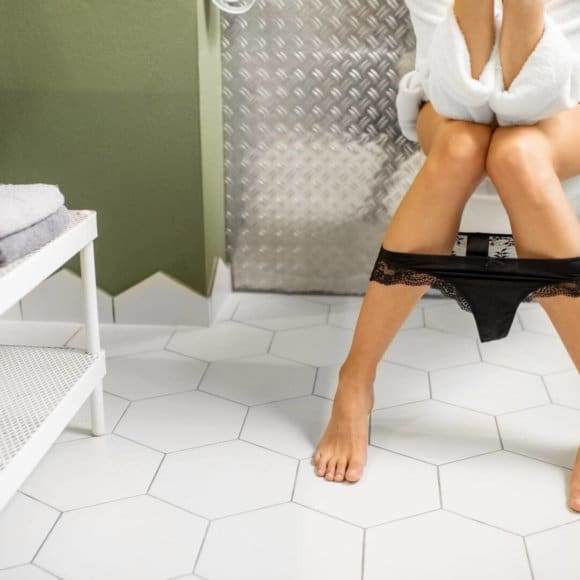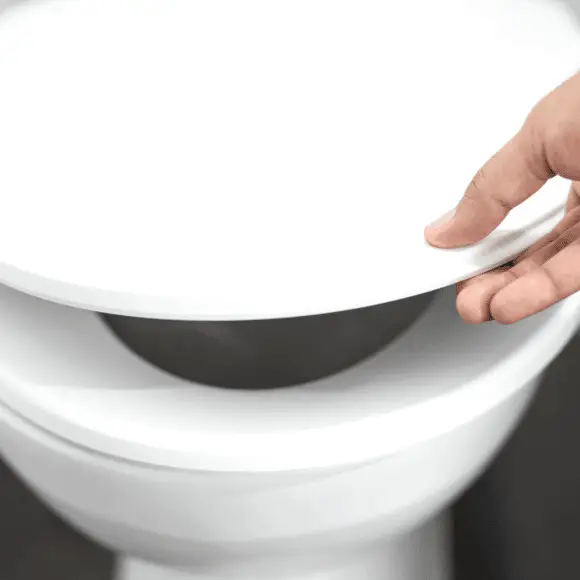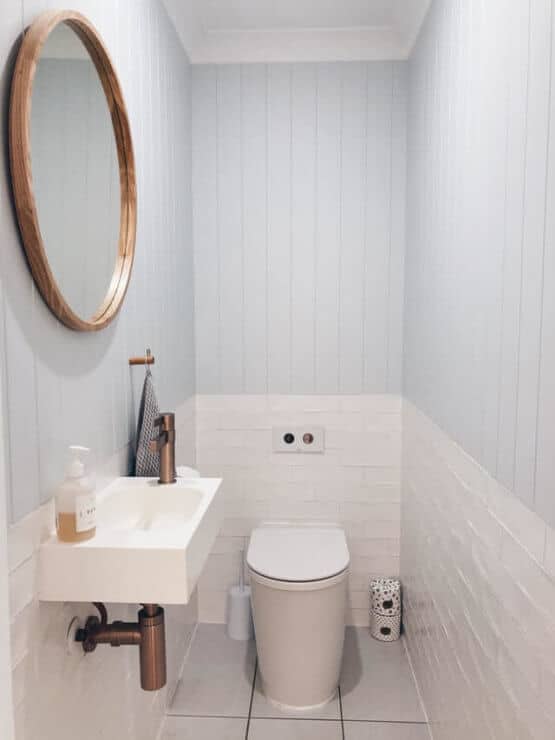In today’s culture, having a toilet is more than a luxury; it’s a need. Therefore, when the toilet is having trouble, it’s critical to figure out what’s causing it and fix it as soon as possible. Toilet flushes but waste comes back is well known problem to everyone.
Clogged toilets are frequently the result of an enthusiastic youngster or adult who overfills the toilet bowl with toilet paper before flushing. These problems are usually resolved by plunging into the lavatory bowl. Still, if poop comes back after flushing, there might be a bigger issue to deal with. [1]
The toilet flushes slowly and incompletely

When you flush waste into a broken or blocked sewer line, the trash doesn’t have anywhere to go and will try to escape by the nearest exit. As a result, the garbage may occasionally return through your bathtub or shower.
Why do toilet flushes have two buttons?
Dual-flush toilets were designed to consume less water while flushing. They include two distinct flushing buttons for two different types of flushing. There is a button for liquid trash and another for solid garbage [3].
When you press the flush button (typically indicated by a green color or a single water droplet image), the toilet performs a “half flush.” Standard bathrooms dispose of waste by a siphoning tube.
The flushing water fills the siphon tube when the toilet is flushed, pushing the wastewater into the drain. The siphoning motion should end once air enters the tube (this is why you must always flush when the toilet lid is down) [4].
Dual-flush toilets do not use the siphoning tube and instead use a larger trap to dispose of waste. Instead of depending on siphoning, gravity is used to drive the wastewater down naturally. Thus, every flush uses less water, including the half-and full-flush buttons.
Toilet flushes but waste comes back? Possible causes
- Non-flushable wipes, paper towels, etc.
Most people wrongly believe certain items can safely be flushed into the toilet. However, wipes, even those labeled as flushable wipes, generate many issues in the residential plumbing system, and they’re also a major problem in the bigger municipal sewage system.
Another product that appears to be flushable is paper towels. However, most paper towel brands are designed to resist tearing even when saturated. Due to their physical resistance, they are tough to break down and travel through the sewer pipe. As a result, you might notice that your toilet leaves paper after flushing
People frequently flush throwaway clothes, feminine products, towels, ear swabs, and hair down the toilet, but it’s vital to remember that the toilet is not a garbage can. These substances are not supposed to be flushed, and flushing them can cause clogs in the toilet or farther down the line, causing persistent problems for the whole plumbing system.
- A blocked S-trap or P-trap
An S-shaped pipe normally rises from the ground and weaves its way into the toilet bowl, as seen from the back of the toilet. An S-trap drain prevents odorous sewer gases from passing into the house via the toilet bowl.
The pipe may not always be visible due to differences in toilet design, and the toilet may employ a P-trap rather than an S-trap in some circumstances, but the function remains the same.
A clogged S-trap or P-trap is obvious to spot because the toilet flushes but waste comes back must be cleaned before being used again. However, if the P-trap or S-trap is partially clogged, the problem may not be visible until the toilet is fully blocked.
Even when the primary clog is cleared, partial blockages can persist, leading the bathroom to stop more frequently. Use a toilet auger to remove or disintegrate the partial obstruction and push it through the drain. If this does not eliminate the clog, you might have to hire a plumber [6].
- Clogged Plumbing Vents
The plumbing system doesn’t merely consist of water pipes to transport water to the multiple media and drainpipes to remove wastewater from the residence.
It also uses ventilation pipes to safely expel sewer gases through the house ceiling rather than allowing pressure to build up in the drainpipes. These lines also allow fresh air from outdoors to get into the system, creating pressure on the line and increasing the toilet’s flushing power.
However, the toilet’s flushing power diminishes if the plumbing vent is shut, clogged, or otherwise hindered. To determine if this is the issue, one person must remain at the toilet while the other goes up onto the roof to inspect the plumbing vent.
Another person should be on the top, holding the ladder and watching the person.
While the person on the roof blocks the vent with their hand, the first person should flush the toilet. If the vent does not have any suction, it is likely blocked and will have to be removed using a plumber’s snake. Alternatively, the vent may be stopped at the exit and only need to be cleared by hand to fix the problem.
- Sewer Line Damage
The sewer line exiting the house may go underground to a public sewer or a septic tank. The sewage line is reasonably well protected against rain, sleet, snow, and ice due to its underground location; however, it is sensitive to tree roots. Tree roots might wrap around the piping or puncture it.
The outflow to the septic tank or public sewer system is restricted if the sewer line is pierced or squeezed. Rocks, dirt, and other debris can also enter the line via the punctures, causing additional drainage issues.
There should be problems with more than one toilet or drain if this is the case. To solve this problem, contact a plumber and be prepared to dig up and replace the main sewer line and replaced.
- Toilet with insufficient flow
Low-flow toilets are fantastic solutions for reducing excessive water consumption and lowering your water bill [7]. On the other hand, toilets can last for more than a decade before they need to be upgraded or replaced. Furthermore, obsolete low-flow toilets can cause clogging problems since the flush force is insufficient to drive toilet paper and waste entirely through the S-trap or P-trap into the drainpipe.
This problem can be alleviated by flushing a tiny bit of toilet roll and wastewater at a time. However, you should replace the toilet with a new low-flow model that can accommodate the demands. You will then avoid scenario where the toilet flushes but waste comes back.
Home remedies for clearing a clogged toilet

If the issue is simply a blockage, you can easily resolve it on your own. You may make your own homemade drain cleaner using items you probably already have on hand. Loosen any drain covers before using these methods to ensure that the clog is cleared as much as possible.
- Dishwashing liquid and hot water
Boil two liters (8 glasses) of water in a large pot. Several tablespoons of liquid soap should be added to the water. Finally, pour the mixture slowly into the drain. It can take a few tries for this to work.
Clogs produced by oil, grease, fats, and organic material respond best to hot water. It is less effective on clogs produced by hair or other materials. If your toilet bowl is made from porcelain or PVC pipes, avoid this procedure as it will cause more damage.
- Wire coat hanger
You could have a wire hanger on hand if you don’t have a plastic drainage stick, which you can get at the store. First, straighten out the hanger, but keep the hook at the end. Then pull anything out of the drain with the hook. Finally, pour some hot water and liquid soap down the sewer after removing as much of the clog as possible.
- Vinegar, salt, and borax
1/4 cup salt, 1/4 cup Borax, 1/2 cup vinegar, and a kettle of boiling water are required. Drop them into the drain, concluding with the hot water. Allow an hour or until the drain clears before rinsing with tap water.
- Vinegar & Baking Soda
Clear the area surrounding your sink, and pour 1/2 cup baking soda and 1/2 cup vinegar down the drain. Allow an hour to pass after plugging your drain. Finally, disconnect the drain and run hot water through it until it clears.
- Salt and baking soda
Mix and pour half a cup of sodium bicarbonate and half a cup of salt down the drain. Allow it to sit anywhere from 30 minutes to overnight. Clear it with a kettle of boiling water after enough time. The longer the mix must sit, the more difficult the blockage is.
- Baking Soda, Salt, and Tartar Cream
In a sealable jar, combine 1/2 cup baking powder, 1/2 cup salt, and two tablespoons cream of tartar. To combine the ingredients, close the jar and shake it. Next, discharge half of the contents of the pot down the drain and keep the other half for another time. A kettle of boiling water should be used to finish the solution. Allow one hour for the drain to drain. Then, rinse any residual solution with tap water.
- Lemon Juice & Baking Soda
Pour 1/2 cup bicarbonate of soda and 1/2 cup lime juice down the drain one at a time. Allow one hour after plugging the drain. Bring a kettle of water to a boil to finish.
- Plunger
You almost certainly have a plunger somewhere. You can purchase one at a utility company, household goods store, or online if you don’t have one. On the other hand, Plungers can only clear obstructions near the surface. A plunger will be ineffective if the obstacle is deeper in the sewer pipe.
- A sewer snake
A sewer snake does not require the help of a plumber. You can get one from your local hardware shop or online. There are several sewer snakes for different sorts of pipelines and obstructions.
Use a flat tape snake if your pipes are less than 2 inches in diameter. If the clog is more stubborn than usual, a power snake with a motor can be used. You can still hire a plumber if you don’t feel at ease doing it yourself.
If neither of those suggestions works, the problem is probably more serious than a blockage. You may be staring at a damaged sewer pipe. You can pinpoint what’s causing waste to return if you book a CCTV drain camera check.
What do to do when a toilet flushes itself?

Toilets sometimes flush on their own, an issue known as “ghost flushing.” The bowl and the tank are the two sections of a toilet.
When you flush the toilet, water from the tank pours into the bowl and washes the contents down the drain. A flapper keeps the water within the tank from seeping into the bowl when the toilet is not being flushed.
The flapper might develop fractures or an algae coating over time, preventing it from creating a tight seal. Random running and ghost flushing can occur when enough water seeps from the tank and into the bowl.
When the toilet tank is sufficiently low, the toilet “flushes,” the tank is refilled with water, and the cycle begins again.
Regularly, some toilets ghost-flush. Other toilets just occasionally ghost-flush. The amount of time between ghost flushes is determined by the severity of the leak.
Related: How To Unclog Toilet When Nothing Works
Toilet flushes but waste comes back? What you can do
The toilet tank components can be repaired or replaced by homeowners who discover their toilet leaks. Switch off the toilet’s water supply and flush the lavatory to empty the water bowl.
Because algae on the flapper can result in water leaking from the tank, begin by disconnecting the flapper from the tank’s bottom and cleaning it.
In case this does not stop the leak, make sure the chain within the tank isn’t so long that it gets stuck underneath the flapper. If the chain is sufficiently long, cut it, so it is no longer a hindrance.
Perhaps neither of these issues is triggering the leak. However, you might need to replace the entire toilet tank assembly in this case. Parts for universal toilet tanks are available at home improvement and hardware stores.
Before installing the toilet tank assembly, read the manufacturer’s instructions. Even if you’ve changed toilet tank parts before, this part is vital because each tank system may have completely different instructions.
Read Next: Toilet Flushes But The Poop Stays

Michael Davis is a heating & plumbing expert who currently works as independent contractor in SC. He also writes for Plumbertip.
For almost 10 years he worked on various plumbing tasks across South Carolina.


